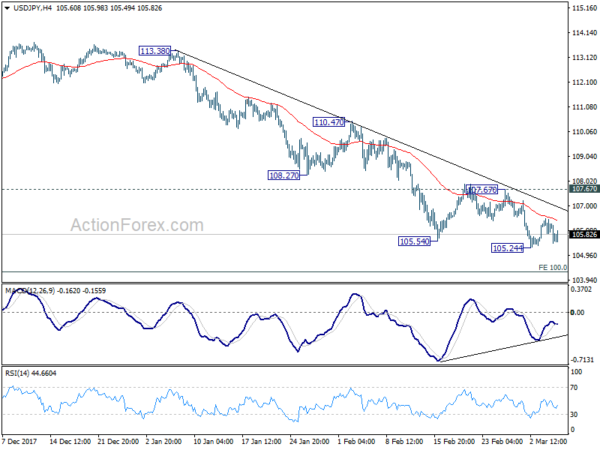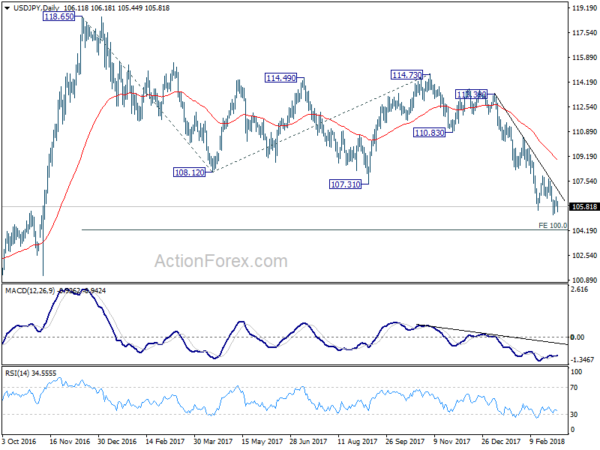Dollar is trying to regain some ground in early US session after better than expected job data. But momentum of the greenback is so far very week. Dollar suffered some selling on news of White House top economic advisor Gary Cohn’s resignation, due to his opposition to President Donald Trump’s steel and aluminum tariff initiative. Global stocks are mixed today, with FTSE trading up 0.2% and DAX up 0.6%, following -0.77% decline in Nikkei. But DOW futures point to sharply lower open. Canadian Dollar continues to trade as the weakest one as markets await BoC rate decision.
Released from US, ADP report showed 235k growth in private sector jobs in February, above expectation of 200k. Prior month’s figure was revised up from 234k to 244k. Trade deficit widened to USD -56.6b in January. Nonfarm productivity was finalized at 0.0% in Q4, unit labor costs at 2.5%. From Canada, trade deficit narrowed to CAD -1.91b in January. Labor productivity rose 0.2% qoq in Q4.
EU leaders discussing counter measures to US tariffs
Markets’ eyes will stay on when and whether Trump would formally sign the order to impose the 25% tariffs on steel and 10% on aluminum. But for today, focus will turn to EU’s plans first. EU leaders are discussing possible counter-measures should the tariffs are imposed. European commission tweeted today that “we have made it clear that a move that hurts the EU and puts thousands of European jobs in jeopardy will be met with a firm and proportionate response”.
European Commission Vice President Valdis Dombrovskis said he hoped that the US initiative of steel and aluminum tariffs “will not be followed through.” But he also warned that ” EU is going to react if these one-sided tariffs are going to be imposed by the U.S.” While EU is assessing the options of possible against against US, Dombrovskis emphasized that “we will react in a firm and proportionate way within WTO rules.” This is inline with the rhetoric of all other EU officials.
It’s reported that EU is considering a 25% tit-for-tat tariff on US goods that worth EU 2.8b, should US imposes the steel and aluminum tariffs.
IMF Lagarde: trade war generally finds losers on both sides
IMF Managing Director Christine Lagarde warned that “in a so-called trade war, driven by reciprocal increases of import tariffs, nobody wins, one generally finds losers on both sides.” The macroeconomic impact could be serious especially if other countries were to retaliate. And, notably, she pointed to the most affected by US steel and aluminium tariffs, including Canada, Europe and Germany. She also pointed to China as a case that “some countries in the world that do not necessarily respect the World Trade Organization’s agreements”.
Released from EU, Euroarea E19 Q4 GDP growth was finalized at 0.6% qoq, 2.7% yoy. EU28 Q4 GDP growth was finalized at 0.6% qoq, 2.6% yoy. In Q4, Estonia ranked top with growth at 2.2%, followed by Slovenia at 2.0% and Lithuania at 1.4%. Greece and Croatia were both at bottom with growth at 0.1%, followed by Italy and Latvia at 0.3%.
Also released in European session, Swiss foreign currency reserves rose to CHF 733b in February, up from CHF 732b.
EU draft Brexit negotiation guidelines reject “mutual recognition
European Council President Donald Tusk is putting forward a draft of Brexit negotiation guidelines. The 6-page document was leaked to Politco. A point to note is that the document rules out UK Prime Minister Theresa May’s proposal of “mutual recognition” of standards.”
It notes that “trade in services … to an extent consistent with the fact that the U.K. will become a third country and the [European] Union and the U.K. will no longer share a common regulatory, supervisor, enforcement and judiciary framework.”
Another point is that financial services is not included in the trade agreement. This certainly disappoints Chancellor Philip Hammond who has been pushing to include it.
Also, the “the European Council has to take into account the repeatedly stated positions of the UK, which limit the depth of such a future partnership. Being outside the customs union and the single market will inevitably lead to frictions.
BoJ deputy nominee Wakatabe: Policy should be date dependent, not date-driven
BoJ deputy governor nominee Masazumi Wakatabe appeared in upper house confirmation hearing today. He said that BoJ has “various things” that can be done under the yield curve control framework. In addition, it can ” strengthen its existing tool kit,” or even “come up with a new policy”. Regarding the 2% inflation target, Wakatable emphasized that the policy is should be data-dependent, not date-driven” and not be bounded by a “set timeframe”. He also cautioned that the impact of the sales tax hike in fiscal 2019 should be watched closely. Another deputy nominee Masayoshi Amamiya said there is still a distant to the 2% target and BoJ needs to continue with powerful easing.
Released from Japan, leading indicator dropped to 104.8 in January, down from 107.4.
RBA Low: No strong case for a near term hike
RBA Governor Philip Lowe expressed his optimism on the economy and said it’s going to be “stronger” in 2018. He pointed to better business conditions “at any time since before the financial crisis.” The economy is “moving in the right direction” and it’s likely that the next move in interest rates is “up, no down”. However, the board does not see a strong case for a near-term adjustment of monetary policy”, thanks to slow progress in unemployment and inflation.
Regarding the steel and aluminum tariffs of the US, Lowe slammed it as “highly regrettable and bad policy”. He added that “history is very clear here. Protectionism is costly.” If it’s confined to steel and aluminum tariffs, Lowe believed “it’s manageable for the world economy.” However, he warned that “this could turn very badly, though, if it escalates.”
Australia GDP grew 0.4% qoq in Q4, below expectation of 0.5% qoq and slowed from prior 0.7% qoq. RBA is generally expected to keep rates on hold throughout 2018, except that NAB predicts one hike. Slowing growth figure in Q4 and risk of trade wars would add to the case for RBA to stand pat.
USD/JPY Mid-Day Outlook
Daily Pivots: (S1) 105.82; (P) 106.14; (R1) 106.43; More…
USD/JPY recovers mildly in early US session but momentum has been week. It’s also kept comfortably below falling 4 hour 55 EMA. Nonetheless, as it’s staying above 105.24 temporary low, intraday bias remains neutral first. Again, as long as 107.67 resistance holds, near term outlook will remain bearish. Break of 105.24 will resume larger decline from 118.65 and target 100% projection of 118.65 to 108.12 from 114.73 at 104.20 next. Firm break there will pave the way to 98.97 key support level and below. However, break of 107.67 will indicate short term bottoming, on bullish convergence condition in 4 hour MACD. In such case, stronger rebound would be seen back to 55 day EMA (now at 108.92) first.
In the bigger picture, current development argues that the corrective pattern from 118.65 is extending. The solid break of 61.8% retracement of 98.97 to 118.65 at 106.48 now suggests that the pattern from 125.85 high is possibly extending. Deeper fall could be seen through 98.97 key support (2016 low). This bearish case will now be favored as long as 110.47 resistance holds.

 Economic Indicators Update
Economic Indicators Update
| GMT | Ccy | Events | Actual | Forecast | Previous | Revised |
|---|---|---|---|---|---|---|
| 00:30 | AUD | GDP Q/Q Q4 | 0.40% | 0.50% | 0.60% | 0.70% |
| 05:00 | JPY | Leading Index CI Jan P | 104.8 | 106.1 | 107.4 | |
| 08:00 | CHF | Foreign Currency Reserves (CHF) Feb | 733B | 735B | 731B | 732B |
| 10:00 | EUR | Eurozone GDP Q/Q Q4 F | 0.60% | 0.60% | 0.60% | |
| 13:15 | USD | ADP Employment Change Feb | 235K | 200K | 234K | 244K |
| 13:30 | USD | Nonfarm Productivity Q4 F | 0.00% | -0.10% | -0.10% | |
| 13:30 | USD | Unit Labor Costs Q4 F | 2.50% | 2.10% | 2.00% | |
| 13:30 | USD | Trade Balance Jan | -56.6B | -52.6B | -53.1B | -53.9B |
| 13:30 | CAD | Labor Productivity Q/Q Q4 | 0.20% | 0.30% | -0.60% | -0.50% |
| 13:30 | CAD | International Merchandise Trade (CAD) Jan | -1.91B | -2.50B | -3.2B | -3.05B |
| 15:00 | CAD | BoC Rate Decision | 1.25% | 1.25% | ||
| 15:30 | USD | Crude Oil Inventories | 3.0M | |||
| 19:00 | USD | Federal Reserve Beige Book |













